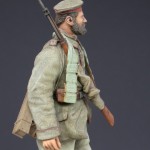
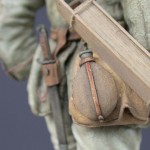
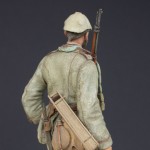
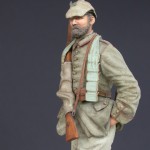
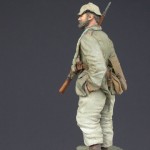
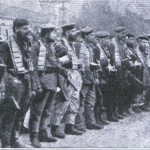
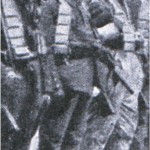
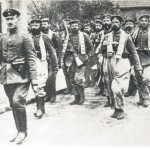
Infantryman. 4th Bavarian Infantry Regiment. Western Front, Spring 1915
- Scale / Maßstab: 1:16
- Approx. height of figure: 115mm
- Material: Resin, Plastic Mirrors / Resin, Spiegel aus Folie
- Parts / Teile: 23
- Infosheet / Infoblatt: English
- Code: 13PH
Contents / Inhalt:
- Figure (7 parts) / Figur (7 Teile)
- Alternative Head / 2. Kopf
- Water Bottle / Feldflasche M1907
- Haversack / Brotbeutel M1887
- Bandoliers
- Ammunition Pouches M1895 / Patronentaschen M1895
- Trench Periscope (4 parts) / Graben-Periskop (4 Teile)
- Bayonet M98/05 / Seitengewehr M98/05
- Mauser Rifle 98 / Mausergewehr M1898
- Spiked Helmet M1895 (2 parts) / Lederhelm mit Spitze M1895 – Pickelhaube (2 Teile)
- Figure Base / Figur-Sockel
Extracts from the Infosheet with this figure:
The figure depicts a member of an infantry platoon marching through a small Belgium town on their way to the trenches. A stocky, well-built character, he is marching in the middle of the first row, with two platoon NCOs and officer in front. These men are dressed for the wet, cold and muddy conditions of trench warfare. They all wear the cotton overall trousers, some tucked into the boots, others have them hanging loose around the ankles. Just before leaving the billets each man was issued a bandolier of extra ammunition to carry around his neck. The sound of the men’s boots on the cobbled road is quite considerable and people are standing watching as the platoon, which with the exception of the officer and but a few of the very younger members all have full beards, go marching by.
Head 1: This head has more of the `tradition´ look of a Bavarian soldier in his mid-twenties with the typical, fashionable full beard of the time. He wears his hair also somewhat longer than would normally have been allowed, but this was sometimes quite common, as units would spend ever-longer periods of time in the front line area. The figure depicts an infantryman in early spring 1915, only weeks before the first time gas was used in the war. He would later most certainly of had to shave off the beard in order that his gas mask fits probably. Bavaria is one of the southern Germen states, which over the centuries, was made up of many different peoples, for instance the Franks (Franco-German), Slavs (Central and Eastern Europe) and Italy. This means that on average the hair colour is either dark brown, or black.
Head 2: This head belongs to Edmund Walle´, who came from the Pfalz area. His surname is French in origin, which was not too uncommon in this part of Germany and dates back to the time of Napoleon 1. The 4 Bayrischen Infantrieregiment was based in Metz before the war and in 1914 Edmund would have been about 20 years old. All the Walle´ men in the family had dark brown, or black hair and dark eyes. He survived both World Wars and died in the late forties. Note: in order that the spiked helmet sits at the correct height, it will be necessary to trim some of the hair.
Spiked Helmet M1895 with Cover / Lederhelm mit Spitze M1895 mit Überzug: Popularly known both in English and German as a `Pickelhaube´. The correct name translated is `Leather Helmet with Spike´. This type of headwear dates back to 1842 and was made out of leather, with the spike, emblem and rim edges in brass. They gave no protection whatsoever during combat. On the front is the state emblem and each side where the chin- strap is attached are the two Kokarden. Right side – Reichskokarden: Imperial cockade. Left side Landeskokarden: State cockade. The chin- strap is on top the helmet cover. In the field these helmets were protected with a cotton cover.
Within the first few months of the static trench warfare, troops were removing the spikes and tucking the remaining excess cloth into the (ventilating) hole. From approx. mid 1915 helmet covers were issued without the spike material. On the figure the spike has been made separately, allowing the helmet to be shown, as it would have been in a front line area at the beginning of 1915. The cover has 4 seams running from top centre of helmet to edge / bottom.
Prussian Line Regiments, (apart from Guards) applied unit numbers in red onto the front of helmet covers. Shortly after the out- brake of war a new directive (in Bavaria on 04.09.1914) stated that all numbers and the letters “R” for Reserve and “L” for Landwehr regiments were to be in a less conspicuous light green. Later, a green cloth was used. Colour: Cover – rush-green (in practice these covers would fade within a short time and the result was a light beige, or grey colour). Chin strap – The standard brown leather chinstrap with two adjustable brass buckles (later steel or matt grey painted steel) lies on top of the helmet cover.
Overtrousers / Überhose: Issued as added protection against the wet and cold. These were designed to fit over the service dress trousers and were held up by attached cloth braces. Either worn with the tunic over the top, or tucked in. Some original photos of troops wearing these over-trousers, gives an untidy impression – a contrast to the summer/autumn manoeuvres and field-grey days of pre-war Germany. Colour: light grey/light brown, depending on condition and age.
Infantry Boots M1866 / Infanteristiefel M1866: The nailed infantry boots for other ranks were made out of leather and had a tendency to `winkle´ down around the ankles after being worn in. Depending on size they had between 35 and 45 nails in the sole and reinforced heel. On each side of the boot shaft are seams where the front and rear of the leather are joined together. Colour: at the beginning of the war the boots had a natural light tan, which was then often darkened by coats of dubbin. As per Army regulation September 1915, boots (and much of the other leather equipment as well) were issued in blackened leather.
Water Bottle / Feldflasche M1907: This had a capacity of 0.8 litres and was attached to the haversack/bread bag by means of a leather strap and buckle. Originally made from aluminium, later Ersatz material and covered with a brown felt material. On one side are the four metal snap fasteners, which were either left blank or painted over in grey. It was quite common for front line troops, particularly during combat periods to carry a second water bottle. The screw on top was in aluminium.
Bandolier: The bandolier was a practical way for carrying extra ammunition and still used in many armies today. This type was designed to hold 70 rounds – 14 x 5 in clips. The bottom 2 pockets on each side were double. Inside, a strip of v-shaped card was fixed along the points of the rounds to stop them damaging (pushing through) the material. On the outside of the pockets are the opening strips (rip off cords), made out of natural coloured sack-material. On some photos one can see 2 lengths of thick string at each end of the bandolier, presumably to attach to equipment. These, for obvious reasons are not on the figure, but can easily be made from cotton thread. Troops would also tuck the bandolier ends into their belts. The fact that this was a `one off – throw away´ item and that it was made out of a thin, low quality material, means that there are few original bandoliers to be seen today and are a sort-after item by collectors. The right hand part of the bandolier, when fixed to the figure should hang freely. Colour: bandolier – blue/grey. Opening strips – brownish-yellow.
Ammunition Pouches M1895 / Patronentaschen M1895: Although outdated, the ammunition pouches M1895 (in Bavaria M1896) were still being used by many infantry units, especially within Reserve-, Landwehr and Landsturm-Regimente at the outbreak of war. These pouches, when full had the tendency to `tip´ forward. This was solved by attaching the haversack carrying strap (an item of kit which was issued, but hardly ever used for what it was meant for) around the neck and hooked onto the pouch buckles (cannot be seen on the figure). Like the other early German ammunition pouches (M87, M88 and M09), the M95 would open outwards, the leather hinge being at the front. The lid straps are on each side, with brass fasteners. Colour: until about 1915/16 all leather equipment was generally issued in natural brown. Later this was blackened. Haversack strap – same as haversack, but with brown leather reinforcements and metal hooks at each end.
Trench Periscope: The homemade periscope would have been made locally, either by himself, or more probably by the unit carpenter. When in use it was quite common to rap sandbag material around the top for better concealment. After removing the casting supports, paint the inside of the periscope before fixing the 2 mirrors supplied onto the 45° slopes. Afterwards add the outside wall-section. The wall-section and the original master are all made out of the same 0.7 mm plywood and therefore give an equal surface grain when painted. Use cotton thread to make a `sling´ and have it hanging loosely over a shoulder, or attached to his belt equipment. Colour: brown wood colour. Note: untreated wood when left outside for longer periods will turn grey.
Mauser Rifle 98 / Gewehr 98: The Gew. 98 derived from the less successful Gewehr 88 and became the standard German infantry rifle of the WW1. It had an overall length of 125 cm (49.25 inch) and fired the 7.92 mm round. It was a good rifle – well made, generally soldier proof and accurate at long ranges. Some of the first models were purchased by the Boers, who used them with great effect against the British in South Africa. Compared with the British Short Magazine Lee Enfield, the Gew. 98 had certain drawbacks. Even in experienced hands it could never keep up with the rate of fire of the British SMLE. A British infantryman could fire 15 aimed shots at 300 yards per minute and with some more experienced men managing 25-30 in the so called `mad minute´. Also, the length of the Gew. 98, especially when fixed with a bayonet was far too long in the confined spaces of the trenches. A further disadvantage was that the bolt handle stuck out at a 90°angle to the rifle, causing it to sometimes snag on uniform and equipment. On the right hand side of the butt there is the small metal disc where the unit identification was stamped. On the right hand side, at the end of the stock are the 2 metal locking splints used to dissemble the rifle. The cleaning rod seen under barrel was only approx. 30 cm long and had to be screwed together using 2 other rods from comrade’s rifles. Without the cleaning rod the rifle could not be stacked in 3s in the typical pyramid fashion of the day (particularly seen with German troops). The breech and trigger, up to the Lange ramp sight have been rapped in an unofficial cloth cover to protect from the mud and dirt of trench life. Colour: wood – brown. Metal – dark metal.
Rifle Sling: The way the rifle is slung around the neck seems to be popular with German troops at this time and is seen on many photos from this period. The brown card supplied can be used to represent leather, or material straps. Cut the card in the required lengths – approx. 1 mm wide and flatten, or rub down on a hard surface with a blunt tool (handle of a modelling knife is ideal). The colour, thickness and texture achieved from rubbing down the card gives a good reproduction of leather in this scale. When fixing the rifle sling, you will find 2 small cavities behind the collar and under the bandolier, for the card to slip into. Colour: brown leather.
Bayonet M1898/1905 / Seitengewehr M1898/1905: This was the so called butcher bayonet, with the distinctive wide blade at the top, near the point. The handle had a wooden grip, with 9 carved angled notches on each side for better grip and the sheath was black. Just above the guard (where the blade starts) is the lubricating hole for the locking mechanism. The bayonet frog – Seitengewehrtasche – would have been natural brown leather, later in the war blackened.
 An deutschsprachige Interessenten:
Sie können mich per eMail oder Telefon auch gerne auf deutsch kontaktieren. Ortsbesuch ist nach Absprache möglich.
An deutschsprachige Interessenten:
Sie können mich per eMail oder Telefon auch gerne auf deutsch kontaktieren. Ortsbesuch ist nach Absprache möglich.
